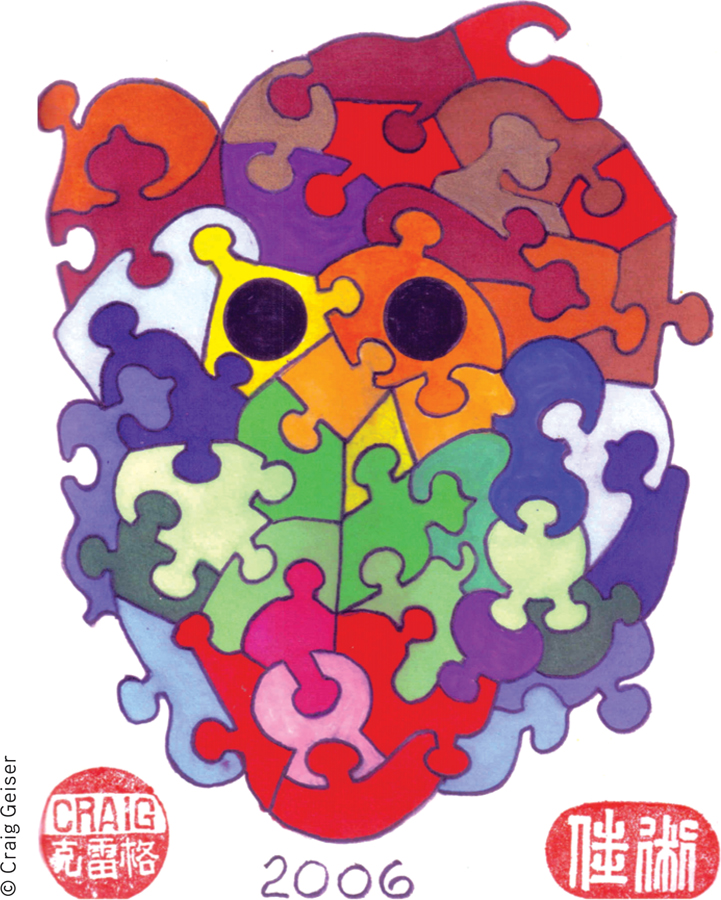52.1 Symptoms of Schizophrenia
“When someone asks me to explain schizophrenia I tell them, you know how sometimes in your dreams you are in them yourself and some of them feel like real nightmares? My schizophrenia was like I was walking through a dream. But everything around me was real. At times, today’s world seems so boring and I wonder if I would like to step back into the schizophrenic dream, but then I remember all the scary and horrifying experiences.”
Stuart Emmons, with Craig Geiser, Kalman J. Kaplan, and Martin Harrow, Living With Schizophrenia, 1997
52-
Schizophrenia comes in varied forms. Schizophrenia patients with positive symptoms may experience hallucinations, talk in disorganized and deluded ways, and exhibit inappropriate laughter, tears, or rage. Those with negative symptoms may have toneless voices, expressionless faces, or mute and rigid bodies.
Disturbed Perceptions
People with schizophrenia sometimes have hallucinations—they see, feel, taste, or smell things that exist only in their minds. Most often, the hallucinations are sounds, frequently voices making insulting remarks or giving orders. The voices may tell the person that she is bad or that she must burn herself with a cigarette lighter. Imagine your own reaction if a dream broke into your waking consciousness, making it hard to separate your experience from your imagination. When the unreal seems real, the resulting perceptions are at best bizarre, at worst terrifying.
Disorganized Thinking and Speech

Hallucinations are false perceptions. People with schizophrenia also have disorganized, fragmented thinking, which is often distorted by false beliefs called delusions. If they have paranoid tendencies, they may believe they are being threatened or pursued.
Maxine, a young woman with schizophrenia, believed she was Mary Poppins. Communicating with Maxine was difficult because her thoughts spilled out in no logical order. Her biographer, Susan Sheehan (1982, p. 25), observed her saying aloud to no one in particular, “This morning, when I was at Hillside [Hospital], I was making a movie. I was surrounded by movie stars…. Is this room painted blue to get me upset? My grandmother died four weeks after my eighteenth birthday.”
Jumbled ideas may make no sense even within sentences, forming what is known as word salad. One young man begged for “a little more allegro in the treatment,” and suggested that “liberationary movement with a view to the widening of the horizon” will “ergo extort some wit in lectures.”
One cause of disorganized thinking may be a breakdown in selective attention. Normally, we have a remarkable capacity for giving our undivided attention to one set of sensory stimuli while filtering out others. People with schizophrenia cannot do this. Thus, tiny, irrelevant stimuli, such as the grooves on a brick or the inflections of a voice, may distract their attention from a bigger event or a speaker’s meaning. As one former patient recalled, “What had happened to me … was a breakdown in the filter, and a hodge-
Diminished and Inappropriate Emotions
The expressed emotions of schizophrenia are often utterly inappropriate, split off from reality (Kring & Caponigro, 2010). Maxine laughed after recalling her grandmother’s death. On other occasions, she cried when others laughed, or became angry for no apparent reason. Others with schizophrenia lapse into an emotionless flat affect state of no apparent feeling. Most also have an impaired theory of mind—they have difficulty perceiving facial emotions and reading others’ states of mind (Green & Horan, 2010; Kohler et al., 2010). These deficiencies occur early in the illness and have a genetic basis (Bora & Pantelis, 2013).
Motor behavior may also be inappropriate. Some perform senseless, compulsive acts, such as continually rocking or rubbing an arm. Others may remain motionless for hours (a condition called catatonia) and then become agitated.
As you can imagine, such disturbed perceptions, disorganized thinking, and inappropriate emotions profoundly disrupt social and work relationships. During their most severe periods, people with schizophrenia live in a private inner world, preoccupied with illogical ideas and unreal images. Many have sleep problems, which can increase night eating and obesity (Palmese et al., 2011). Given a supportive environment and medication, over 40 percent of people with schizophrenia will have periods of a year or more of normal life experience (Jobe & Harrow, 2010). Many others remain socially withdrawn and isolated or rejected for much of their lives (Hooley, 2010).